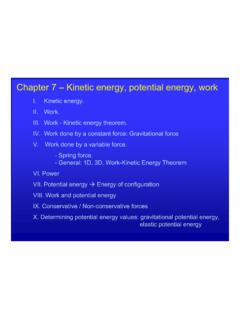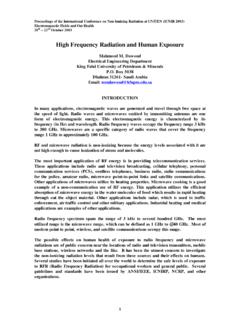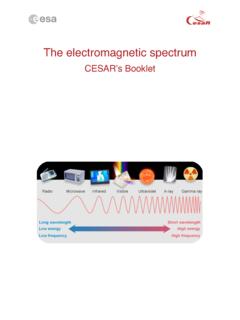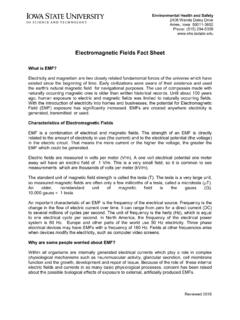Transcription of Black Body Radiation
1 1/10/13 1:12 PMBlackbody RadiationPage 1 of 7 Black Body Radiation Astronomy Main. INTRODUCTION . A Black body is a theoretical object that absorbs 100% of the Radiation that hitsit. Therefore it reflects no Radiation and appears perfectly practice no material has been found to absorb all incoming Radiation , but carbon in itsgraphite form absorbs all but about 3%. It is also a perfect emitter of Radiation . At aparticular temperature the Black body would emit the maximum amount of energy possible forthat temperature. This value is known as the Black body Radiation . It would emit at everywavelength of light as it must be able to absorb every wavelength to be sure of absorbing allincoming Radiation . The maximum wavelength emitted by a Black body radiator is infinite. Italso emits a definite amount of energy at each wavelength for a particular temperature, sostandard Black body Radiation curves can be drawn for each temperature, showing the energyradiated at each wavelength.
2 All objects emit Radiation above absolute zero.. Some Examples: Objects at around room temperature emit mainly infra-red Radiation (l 10mm) which isinvisible. The sun emits most of its Radiation at visible wavelengths, particularly yellow (l ). A simple example of a Black body radiator is the furnace. If there is a small hole inthe door of the furnace heat energy can enter from the outside. Inside the furnace this isabsorbed by the inside walls. The walls are very hot and are also emitting thermal may be absorbed by another part of the furnace wall or it may escape through the wholein the door. This Radiation that escapes may contain any wavelength. The furnace is inequilibrium as when it absorbs some Radiation it emits some to make up for this and eventuallya small amount of this emitted Radiation may escape to compensate for the Radiation thatentered through the hole. Stars are also approximate Black body radiators. Most of the lightdirected at a star is absorbed. It is therefore capable of absorbing all wavelengths of1/10/13 1:12 PMBlackbody RadiationPage 2 of 7 Radiation , so is also capable of emitting all wavelengths of electromagneticradiation.
3 Most approximate blackbodies are solids but stars are an exception because thegas particles in them are so dense they are capable of absorbing the majority of the BODY Radiation CURVESFig 1: Theoretical Black body curve for 5000 KThe Black body Radiation curve (Fig1) shows that the Black body does radiate energy at everywavelength. The curve gets infinitely close to the x-axis but never touches it. The curvetouches at infinite wavelength. It also shows that the Black body emits at a peak wavelength,at which most of the radiant energy is emitted. At 5000K the peak wavelength is about5x10-7m (500nm) which is in the visible light region, in the yellow-green section. At eachtemperature the Black body emits a standard amount of energy. This is represented by thearea under the curve. 1/10/13 1:12 PMBlackbody RadiationPage 3 of 7 2: Black body Radiation curves showing peak wavelengths at various temperaturesThis graph shows how the Black body Radiation curves change at various temperatures.
4 Theseall have their peak wavelengths in the infra-red part of the spectrum as they are at a lowertemperature than the previous graph. The graph shows: . As the temperature increases, the peak wavelength emitted by the Black body It therefore begins to move from the infra-red towards the visible part of the , none of the graphs touch the x-axis so they emit at every wavelength. This means thatsome visible Radiation is emitted even at these lower temperatures and at any temperatureabove absolute zero, a Black body will emit some visible light. The graph also shows: . As temperature increases, the total energy emitted increases, because the total area underthe curve increases..It also shows that the relationship is not linear as the area does not increase in even 1:12 PMBlackbody RadiationPage 4 of 7 rate of increase of area and therefore energy increases as temperature 'S LAWlp = constant lp = Peak Wavelength (m) T = SurfaceTemperature (K) Constant = x 10-3 mKThis rearranges to lp = x 10-3 / TThis rearranged equation shows why the peak wavelength decreases as temperatureincreases.
5 This decrease in wavelength explains why objects glow first red, then orange-red,then yellow, then even blue. These colours are successive decreases in wavelength. STEFAN'S LAW P = Power radiated in W (J/s) s = Stefan's Constant x 10-8 W m-2 K-4 A = Surface area of body (m ) T = Temperature of body (K)Therefore the Power radiated is proportional to T4 for an identical body which explains whythe area under the Black body curves (the total energy) increases so much for a relativelysmall increase in temperature. PLANCK ENERGY DISTRIBUTION FORMULA Pl=Power per m area per m wavelength h = Planck's constant ( x 10-34 Js) 1/10/13 1:12 PMBlackbody RadiationPage 5 of 7 c = Speed of Light (3 x 108 m/s) l = Wavelength (m) k = Boltzmann Constant ( x 10-23 J/K) T = Temperature (K)This complex looking formula is used to plot the Black body curves for each temperature byworking out the power emitted at each wavelength. A complex formula such as this will givethe complex shape of a Black body curve.
6 Click here to see more. ULTRAVIOLET CATASTROPHEIn the 19th century a major problem for physicists was to predict the intensity of radiationemitted by a Black body at a specific wavelength. Wilhelm Wien made a theory that predictedthe overall form of the curve by treating the Radiation as gas molecules. However, at longwavelengths his theory disagreed with experimental data. Rayleigh and Jeans then produced aformula by considering the Radiation within the Black body cavity to be made up of a series ofstanding waves. They thought that electromagnetic Radiation was emitted by oscillating atomsin the walls of the Black body and this Radiation set up a standing wave between the walls. Their formula stated: I = Intensity However, this formula also had a problem. For large wavelengths it fitted the experimentaldata but it had major problems at shorter wavelengths. The problem was the l term in thedenominator. It meant that as the wavelength tended to zero, the curve would tend toinfinity.
7 However we know that there is a peak wavelength for each temperature, and theenergy emitted at either side of this peak dropped. The Rayleigh-Jeans Law predicted nopeak wavelength. 1/10/13 1:12 PMBlackbody RadiationPage 6 of 7 3 : Comparison of Experimental Black body data and Rayleigh-Jeans LawTherefore the wave theory of the time could be used to explain behaviour on either side ofthe peak, but the peak would be infinitely high. The failure of these formulae to account forthe decrease in energy emitted at short wavelengths (the ultraviolet wavelengths) becameknown as the ultraviolet catastrophe. A major breakthrough was made by Max Planck whomade a formula that agreed with experimental data, which is showed above. However, he hadmajor problems proving this law. His idea was that the oscillating electrons of the surfaceatoms of the Black body emitted Radiation according to Maxwell's laws of Planck it was assumed that these could have any value of energy but Planck decidedthat the energy must go up in discrete amounts (quantised) because the frequencies of theoscillating electrons could only take certain values.
8 As energy is proportional to frequency (E =hf) , where h is the Planck constant x 10-34 Js) if frequency can only take discretevalues, this means that energy is also quantised. The electrons have a fundamental frequency(like standing waves on a string) and the frequency can only go up in whole multiples of thisfrequency, called the quantum number. This assumption led Planck to correctly derive hisformula. If he ignored the quantised energy, he obtained the Rayleigh-Jeans formula. Einsteintook the next step by working out that all Radiation is quantised. He argued that an oscillatingcharge can accept or lose energy in small values of DE = hDf. This energy is lost as1/10/13 1:12 PMBlackbody RadiationPage 7 of 7 Radiation . Therefore this Radiation must be emitted in small packets, eachcontaining DE. He then suggested that each energy of Radiation will have its own he no longer thought of Radiation from an object as continuous. He said itconsisted of a series of "packets" of energy.
9 This meant that Radiation was being thought ofas a "packet of energy" but also as a wave because it had a frequency. These became known PHOTOELECTRIC EFFECT This is an effect that is best explained by Einstein's photon model of electromagneticradiation. Click here to see the light is shone on metal , the surface maybecome positively charged. This is because electrons gain energy from the light waves, andare able to leave the metal's surface. However, there were some strange effects that couldnot be explained by considering light as a wave. The frequency of the light must be above acertain threshold value for that metal for electrons to be emitted. For example blue lightcauses sodium to emit electrons but red light does not. If light was a wave the electronswould eventually absorb enough energy to be emitted, regardless of frequency. Also,incredibly weak beams of light can cause electrons to be emitted. If light was a wave andspread out you would not expect any electrons to obtain the energy to escape.
10 Finally it wasdiscovered that the kinetic energy of the electrons depends not on the intensity of the lightbut on its frequency. A very weak ultraviolet beam will give electrons a higher kinetic energythan a very bright blue beam of light. Einstein explained this by saying that the light arrivedin photons. One photon gave all its energy to one electron. Click here to see the equation. Theelectron must gain a certain amount of energy to overcome the forces that hold it inside themetal. It appears that one electron can only accept one photon of energy, so this must havethe required frequency to have the necessary escape energy, so the intensity will not makeany difference to this. Brighter light means there are more photons, so more electrons can beemitted, but it is the frequency of the light that decides the energy of the photon and so theelectron's kinetic energy. Electrons can also be emitted very quickly because it only requiresone photon for emission to occur, not the gradual build up of wave to the topPage Contributed by , student 2000/2001, edited by.


















